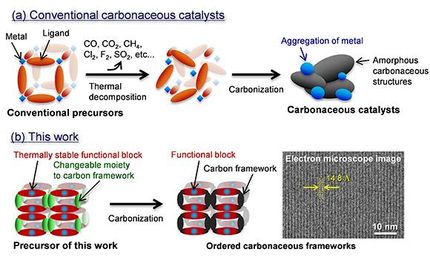Platinum nanoparticles "burrow" into a zeolite support and form new pores
Advertisement
Catalytic converters in cars consist of tiny platinum particles that have been deposited onto a porous ceramic support. At high temperatures, these particles can sinter, meaning that they fuse together with the support material and undergo chemical reactions. What is going on at the nanoscopic scale? Could these processes be useful? Japanese researchers working with Hitoshi Kato have examined more closely platinum particles on a zeolite surface using an electron microscope. They have made a surprising find: particles that "dig" corridors.
Zeolites are crystalline, highly porous silicates. Because of their large surface area and their cage-like pores, which can take up "guest molecules", they are used as ion exchangers, molecular sieves, and catalysts. The researchers chose one of these zeolites as a support for their platinum particles and exposed them, at 800 °C, to an atmosphere equivalent to that in an average car exhaust. After one hundred hours, they looked at the little platinum-containing zeolite crystals under an electron microscope. Amazingly, there were no more platinum particles to be found on the surface of the zeolite. Where could they have gone? The surprising discovery: the tiny spheres of precious metal had burrowed into the surface of the zeolite. In the process, they left behind little channels with a diameter corresponding to the diameter of the particles. The researchers noted that there was a preferred direction for the channels within the zeolite crystals. The channels have a hexagonal cross-section, which is in agreement with the lattice structure of the zeolite, and the channel walls consist of facets of the crystal. Aside from a platinum sphere at the end of each pore, they are empty and the surrounding crystal structure is not disturbed in any way. Atoms have clearly just disappeared from the crystal lattice. At the points of contact between the platinum particles and the zeolite, the platinum presumably catalyzes a chemical reaction between the silicon and oxygen atoms of the zeolite and the components of the exhaust. The components of the zeolite can thus leave the crystal in the form of gaseous SiO or Si(OH)4. The platinum particles "sink" deeper and deeper into the holes formed by the reaction.
"The observed phenomenon could be used to produce tailored porous materials," hopes Kato. "The number of pores, as well as their shape and size could be controlled by the diameter of the platinum particles, the duration of heating, the type of zeolite selected, and the orientation of the crystals."
Most read news
Other news from the department science

Get the chemical industry in your inbox
By submitting this form you agree that LUMITOS AG will send you the newsletter(s) selected above by email. Your data will not be passed on to third parties. Your data will be stored and processed in accordance with our data protection regulations. LUMITOS may contact you by email for the purpose of advertising or market and opinion surveys. You can revoke your consent at any time without giving reasons to LUMITOS AG, Ernst-Augustin-Str. 2, 12489 Berlin, Germany or by e-mail at revoke@lumitos.com with effect for the future. In addition, each email contains a link to unsubscribe from the corresponding newsletter.




























































